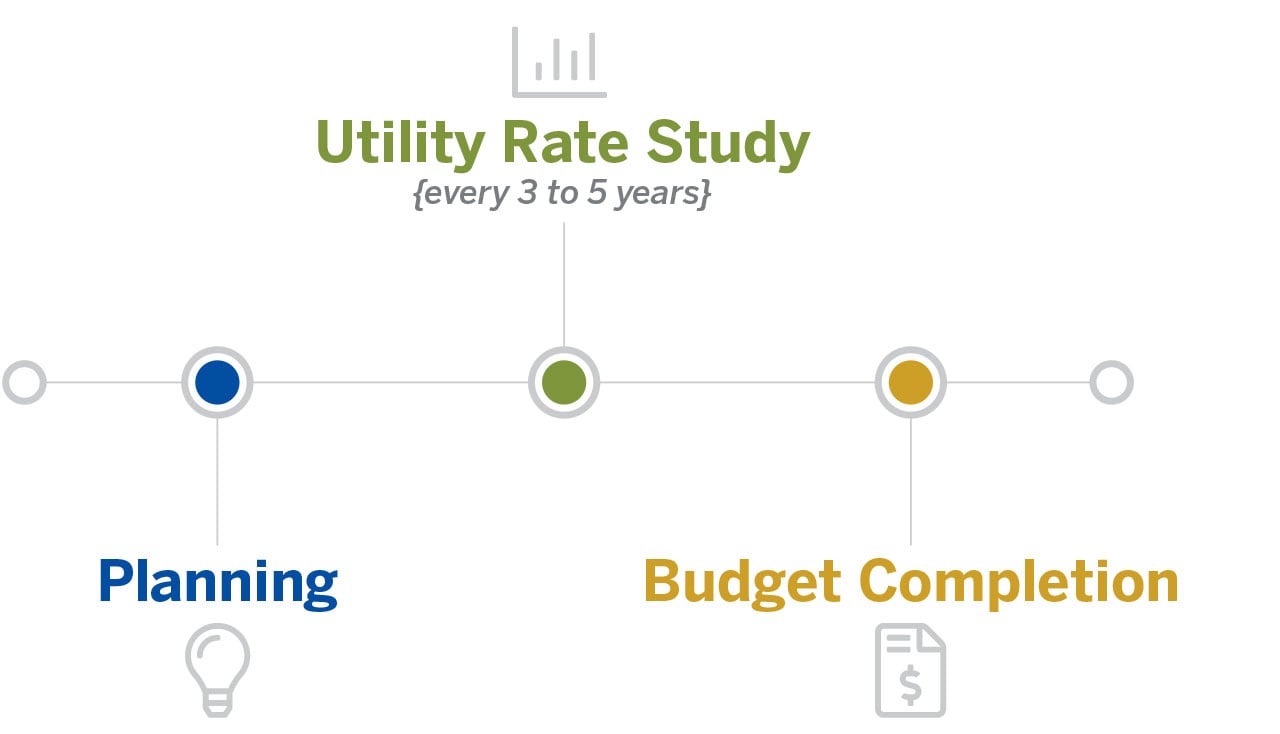Performed regularly, water utility rate studies provide transparency into what your utility can expect in the years ahead. They ensure you have the financial resources needed to meet your budget, maintain your infrastructure, grow your distribution system, explore new technologies and implement your capital improvement plan (CIP).
One of the most pressing challenges for water utilities involves updating and approving equitable (i.e., fair and balanced) water rates to ensure sufficient revenues are being generated. For your utility to be well run and financially sound, at a minimum the revenue you generate from water utility sales, services and other sources must meet all operating and non-operating expenses.
Water utility rate studies offer a practical and highly effective solution.
Throughout this article, we explore how water utility rate studies can improve your planning and project efforts, four benefits and where you should begin. Interested in digging deeper into this complex process? We would be happy to further expand and discuss how it may support your community!
What exactly is a water utility rate study? How often should they be performed?
A utility rate study is a financial review of a water utility that projects future revenue and expenses, usually for the next five years. The ultimate purpose of a water utility rate study is to determine whether your operating revenues are sufficient to meet your expenses, the cost of operations and maintenance, upcoming or needed replacements and debt service, and to help you make capital improvements during the implementation plan period.

A community’s first utility rate study is often performed after planning but before completion of its public works budget. Ideally, one should be performed every 3-5 years and coincide with that year’s public works budgeting process. If you complete a rate study outside of this window, users will likely experience a significant rate spike to meet the water utility’s expected needs.
A water utility rate study relies on past and present data, your public works budget and other key pieces of information (further explored below) to project the next several years of rate needs for your water utility.
The rate study process is complex, detailed and includes a strategic implementation plan – developed specifically to supplement your CIP.

Above is a summary of a five-year rate structure developed by SEH on behalf of a Midwest community (population ~13,000) as part of a 72-page water utility rate study. SEH reviewed the utility’s operating and capital expenses for the water and sanitary sewer systems and developed a financial plan and cost-based rates for both systems. The study provided the City with recommendations for the implementation of equitable rates and rate structures to meet the needs of each system, while also promoting water conservation in accordance with state statutes and maintaining financial reserves for operational stability.
4 ways your city benefits from a water utility rate study
1. Effective at informing your total revenue requirements
Determining a municipal water utility’s revenue requirement is foundational to setting the overall level of utility rates that need to be applied and charged to users. This also provides your municipal water utility with adequate and sustainable funding levels for operations, maintenance and capital improvement expenses, as well as a basis for annual budgeting.
2. Provides revenue stability and predictability
Revenues are the lifeblood of every municipal water utility. Without adequate revenues, quality of service often deteriorates due to a lack of proper maintenance and system improvements. A lack of revenue also makes it extremely difficult for a water utility to be financially and operationally sustainable.
Conversely, revenue stability and predictability prepare your municipal water utility for long-term success. Just as importantly, they provide an accurate financial understanding of fixed assets, inventory and the processes required to meet your utility’s distribution needs. Revenue stability and predictability also help identify when you should act to meet these needs, consistent with your CIP.
3. Ensures fairness in the distribution of total costs of service among different ratepayers
Utility rate studies result in a more equitable cost-allocation methodology. Developing an equitable and actionable strategy designates the costs of providing water service to customers of all types by user categories.
4. Plays an instrumental role in utility rate design
Utility rate studies make it possible for utility managers and board members to review your current water rate structure and provide a rate design that is cost based, justifiable to the public and meets the specific rate design objectives needed to maintain and grow your utility.
Process overview – What does a water utility rate study involve?

1. Review water utility’s current rate structure
At SEH, when conducting a utility rate study, our economic development, utility finance and utility engineer professionals review your water utility’s current rate structure, historical financial information, planned capital improvements and debt obligations.
We then factor in inflation to uncover and recommend a five-year cost estimate for your water utility based on various maintenance and growth scenarios. Next, we work with you to develop a five-year implementation plan to align with and supplement your CIP.
2. Analyze current rate structure ability to generate revenue
After determining projected costs associated with the implementation plan for your water utility system, SEH professionals analyze the current rate structure’s ability to produce sufficient revenue in order to fund improvements during the five-year implementation period.
Depending on these results, we work with your water utility to adjust the rates or recommend an alternative rate structure that will meet the needs of the implementation plan.
3. Calculate utility rates
Utility rates are calculated based on the revenue your water utility will require to meet its financial obligations and anticipated expenses, plus the funds needed to maintain sufficient cash reserves.
There are several possible rate structures that will be considered during a water utility rate study. Each of the following structures have advantages and challenges; uncovering which is right for your utility depends on your individual needs and the political environment, and requires detailed exploration.
For example, it’s important to consider how a particular rate structure will affect your billing procedures and the diverse demographics of your utility users – senior residents, businesses and non-profits, among other types of users.
Common rate structures include:

A. Uniform rates – A uniform rate is a constant unit price for all metered volumetric units of water consumed on a yearly basis. Uniform rates require metered service and can be applied to all customer classifications.
B. Decreasing block rates – A decreasing block rate is a rate structure in which the unit price of each succeeding block of usage is charged at a lower unit rate than the previous block(s). The number of rate blocks and the size and pricing of each block vary by utility.
C. Increasing block rates – Increasing block rates are volumetric chargers, meaning the rate per unit of water increases as the volume of consumption increases. Increasing block rates require metering and defining consumption blocks over which rates increase.
4. Determine whether operating revenues are sufficient
As noted above, the primary goal of a water utility rate study is to determine whether your operating revenues are sufficient to meet your current, upcoming and potential expenses, and help you make capital improvements during the implementation plan period.
Typically, water utility rate studies should be performed every 3-5 years. However, timing depends on what is right for your utility and your service area. Some utilities raise rates annually to keep up with inflation and minimize the shock to its ratepayers; others opt for a larger increase every few years.
5. Develop a financial plan and cost-based rates
Raising rates and asking for more from the community is never the goal yet often unavoidable. It’s important to help your customers understand how rates are developed, why costs may need to increase, and how their dollars are used to provide an uninterrupted supply of safe, healthy, potable and reasonable priced water while maintaining sound and sustainable finances.
Utility rate studies provide the transparency and research you need to help your customers understand.
Questions? Let’s connect.
A well-run water utility is critical to your community’s health, economic development and overall quality of life. Water utility rate studies can help get you there in the most effective and efficient manner.
At SEH, we’re passionate about leading communities of all sizes through this process and helping you develop a strategic financial and operational plan that will ensure quality services for years to come.
Want to learn more about the water utility rate study process, what goes into a report and subsequent plan, or simply discuss potential solutions to your challenges? Share your questions below, and we'll be in touch!
About the author

Damon Tsouklis is a Senior Economic Development Professional with 35+ years of experience in water utility financing. Damon regularly provides financial advisory services to municipalities – including bookkeeping; economic development finance; tax increment financing; financial feasibility, utility rate and cost of service studies; and municipal budgeting.

.png?width=113&name=SEH_Logo_RGB%20(1).png)

